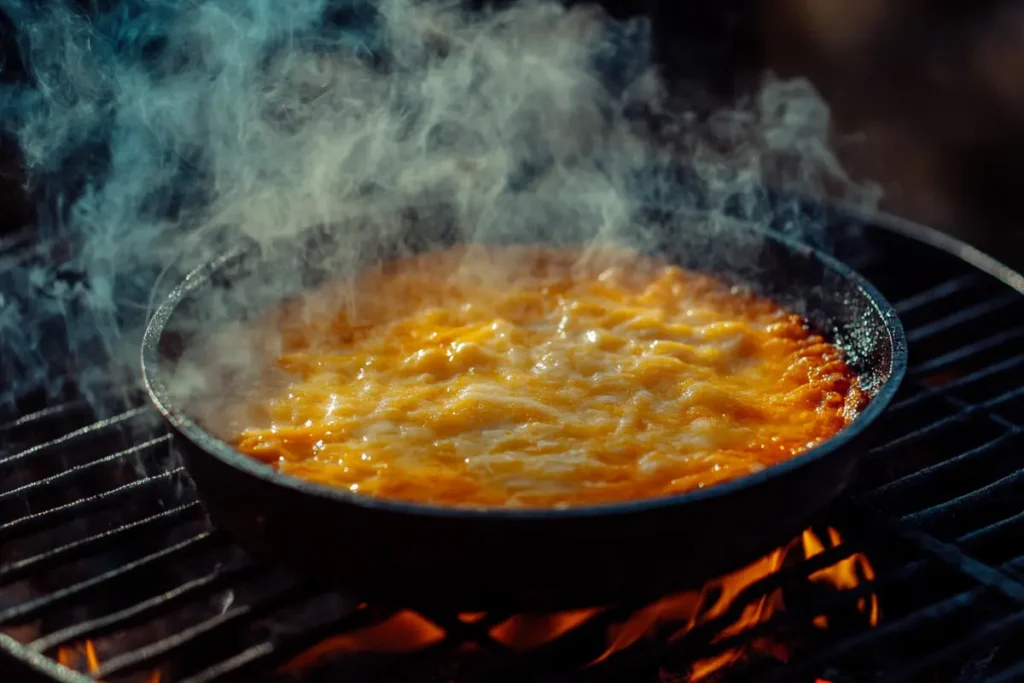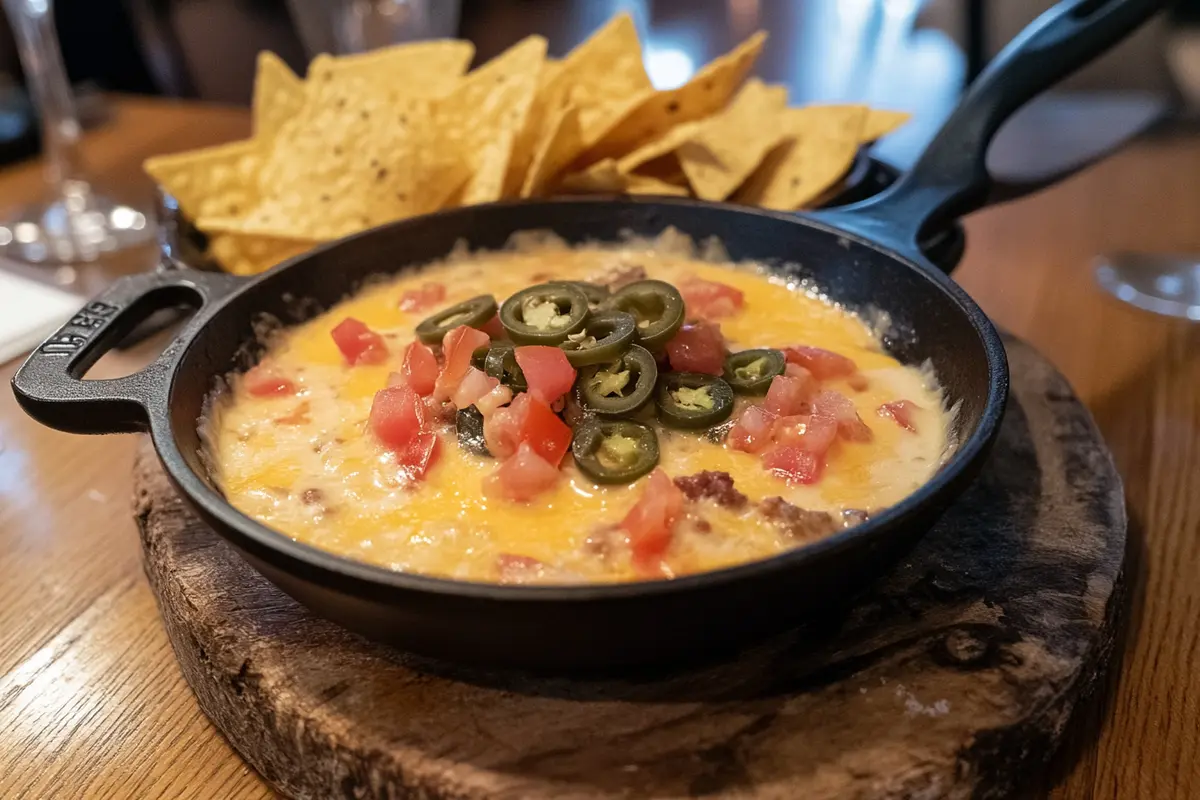What Temperature Should You Smoke Queso At?
Smoking queso has quickly become a popular way to elevate a simple cheese dip into a rich, flavorful appetizer that impresses everyone at the table. From its creamy texture to the smokiness infused by the process, smoked queso offers a delightful experience. But achieving perfection isn’t just about tossing cheese into a smoker — it’s all about getting the temperature right. In this article, we’ll explore the ideal temperature for smoking queso, how to prepare and smoke it step-by-step, and even troubleshoot common issues. Let’s dive in!
Introduction to Smoked Queso
What is Smoked Queso?
Smoked queso is a cheesy dip enhanced with the flavors of smoke, giving it a savory, smoky depth. It typically combines various cheeses, meats, vegetables, and spices in a cast-iron skillet, all heated together in a smoker. The smoky aroma and gooey texture make it a standout appetizer for gatherings or game days.
Why Smoking Adds Flavor to Queso
Smoking isn’t just for meats—it’s a game-changer for cheese, too! The low, slow heat in a smoker gently melts the queso while infusing it with subtle hints of smokiness. Whether you use mesquite, hickory, or fruitwood, the flavor of the smoke clings to the cheese, creating a complex and memorable taste. Plus, it pairs perfectly with everything from tortilla chips to fresh veggies.
Overview of Ideal Temperature for Smoking Queso
So, what temperature should you smoke queso at? The sweet spot is between 225°F and 250°F. This range, therefore, allows the cheese to melt evenly without burning or separating. In addition, at these temperatures, the smoky flavor has enough time to permeate the ingredients without overcooking them. However, maintaining consistency in this range is crucial for achieving the best results.
Smoked queso combines culinary creativity with technical precision, making it, thus, a must-try for anyone looking to elevate their appetizer game. Stick around, because we’ll guide you through every detail, starting with how to choose the right smoking temperature.
Choosing the Right Temperature for Smoked Queso
Recommended Smoking Temperature: 225°F to 250°F
What temperature should you smoke queso at? The recommended range is between 225°F and 250°F. At this low-and-slow heat, the cheese melts evenly without separating, maintaining its creamy texture. Smoking queso at these temperatures allows the smoky flavor to thoroughly infuse the dip while preventing overcooking. Consistency is key, so keep a thermometer handy to monitor the smoker.
Factors Affecting the Smoking Temperature
Various factors influence the ideal temperature for smoking queso. Outdoor weather can impact the smoker’s performance, especially on windy or cold days. Additionally, the type of cheese used plays a role—softer cheeses may melt faster than harder ones. Adjusting the smoker’s vents and fuel source can help maintain a steady heat.
Maintaining Consistent Heat for Perfect Results
Achieving consistency at 225°F to 250°F requires a well-prepared smoker. Preheat the smoker before adding the queso, and use wood chips or pellets to sustain the desired heat. Opt for woods like hickory, mesquite, or cherry for added flavor. If you notice temperature fluctuations, adjust your fuel or vents promptly.
Preparing to Smoke Queso
Ingredients for Smoked Queso
To create a delicious smoked queso, you’ll need cheeses like cheddar, Monterey Jack, or Velveeta, along with diced tomatoes, green chilies, and optional ingredients like cooked sausage, jalapeños, or onions. The combination of flavors makes this dip both versatile and crowd-pleasing.
Tools and Equipment You’ll Need
A successful smoked queso requires the right tools. Use a smoker (pellet or charcoal), a cast-iron skillet to hold the ingredients, and a reliable thermometer to maintain the proper smoking temperature. Tongs, aluminum foil, and wood chips are also essential for managing the smoking process.
Preparing Your Smoker for Queso
Before starting, clean your smoker to avoid residual flavors from previous recipes. Preheat it to 225°F to 250°F and add your chosen wood chips or pellets. Arrange the ingredients in a cast-iron skillet, ensuring even distribution for uniform melting. Once the smoker is ready, you’re all set to begin the smoking process.
Step-by-Step Guide to Smoking Queso
Assembling the Ingredients in a Cast-Iron Skillet
The first step in creating smoked queso is assembling the ingredients. Choose a large cast-iron skillet to hold everything evenly. Start by layering your base cheeses like cheddar or Monterey Jack, then add diced tomatoes, green chilies, cooked sausage, or your favorite toppings. Keep the ingredients evenly distributed so the flavors meld beautifully during smoking. If you’re using Velveeta, cut it into small cubes for even melting.

For an extra kick, sprinkle in jalapeños or a dash of smoked paprika. These ingredients elevate the dip and complement the smoky flavor you’ll get from the smoker.
Placing Queso in the Smoker
Once the ingredients are prepped, place the skillet directly onto the smoker’s grate. Preheat the smoker to 225°F to 250°F, which is the ideal range for ensuring your queso melts evenly and absorbs a rich, smoky flavor. Close the lid to trap the smoke and maintain a consistent temperature.
Let the queso smoke for about 45 minutes to 1 hour, stirring occasionally to blend the ingredients. You’ll notice the cheeses melting into a gooey consistency while taking on a golden, smoky hue. If the temperature drops, adjust your fuel or vents to keep it steady.
How Long Should You Smoke Queso?
The smoking time for queso typically ranges from 45 minutes to 1 hour, depending on the type of smoker and the consistency you prefer. Therefore, it’s essential to keep an eye on the queso to prevent overcooking. However, if it becomes too thick, you can add a splash of milk or cream to achieve your desired texture.
In addition, you might wonder, What temperature should you smoke queso at? Always stick to 225°F to 250°F for the best results. This way, the cheese melts smoothly without burning or separating, ensuring a perfectly creamy dip.
Troubleshooting and Adjustments
What to Do If the Queso Cooks Too Fast or Too Slow
Sometimes, queso may cook unevenly due to temperature fluctuations. If it cooks too fast, reduce the smoker’s heat and stir frequently to prevent the edges from burning. On the flip side, if the queso cooks too slowly, check your smoker’s fuel and vents. Maintaining a steady temperature of 225°F to 250°F is key to success.
Adjusting Smoking Times for Weather Conditions
Weather can impact smoking times significantly. On windy or cold days, your smoker might struggle to maintain heat, requiring extra fuel or adjustments to the vents. In warmer conditions, monitor the smoker closely to prevent overheating. Using a reliable thermometer can help you keep the temperature consistent despite external factors.
Common Mistakes When Smoking Queso and How to Avoid Them
- Using the Wrong Temperature: Always stick to the recommended range of 225°F to 250°F. Lower temperatures might not melt the cheese properly, while higher ones can cause it to burn or separate.
- Skipping Stirring: Failing to stir the queso periodically can result in uneven melting and burnt edges.
- Overloading the Skillet: Avoid overcrowding the skillet, as this can prevent the ingredients from melting evenly.
For more delicious recipes, check out our guide on creamy tortellini soup, a perfect dish to complement your smoked queso experience!
Flavor Variations and Enhancements
Adding Meat, Vegetables, or Spices

One of the best things about smoked queso is its versatility. You can easily customize it by adding your favorite ingredients. For a meaty twist, include cooked sausage, ground beef, or even shredded chicken. These proteins add a hearty flavor that pairs well with the smoky aroma.
If you prefer a veggie-packed dip, toss in diced bell peppers, onions, or jalapeños for a pop of color and a hint of heat. You can also experiment with spices like smoked paprika, cumin, or chili powder to deepen the flavor profile. No matter the mix-ins, the low, steady temperature of 225°F to 250°F ensures everything blends beautifully.
Pairing Smoked Queso with Dipping Options
The fun doesn’t stop with the queso itself—pair it with creative dipping options to make it shine! Tortilla chips are a classic choice, but you can also serve it with pretzels, fresh vegetables, or even crusty bread. For a unique twist, try pairing smoked queso with homemade pita chips or soft pretzel bites. The smoky richness of the queso complements a variety of textures and flavors, making it a hit at any gathering.
Creating a Smokier Flavor Profile
For an even smokier flavor, experiment with different wood chips. Hickory and mesquite offer bold, intense smoke, while apple or cherry wood adds a subtle sweetness. Adjust the smoking time slightly if needed but stick to the sweet spot of 225°F to 250°F for optimal results.
Health and Safety Tips When Smoking Queso
Food Safety Tips During Smoking
Smoking queso at the proper temperature isn’t just about flavor—it’s also essential for safety. Maintaining a consistent range of 225°F to 250°F ensures that ingredients like cheese and meats are thoroughly heated. Use a thermometer to verify that all components reach safe temperatures, especially if you’ve added raw meat to the mix.
Keep the smoker clean to avoid cross-contamination from previous recipes. Always use fresh, high-quality ingredients to minimize the risk of spoilage or foodborne illness. If you’re preparing queso for a large group, serve it in smaller batches to keep it fresh and at a safe serving temperature.
Ensuring Ingredients Cook Evenly
Even cooking is key to achieving the creamy texture that makes smoked queso irresistible. To ensure even melting, cut all ingredients into small, uniform pieces before adding them to the skillet. Stir the queso regularly while it smokes to distribute the heat and prevent burning.
By following these safety tips, you can enjoy smoked queso worry-free. Wondering what temperature should you smoke queso at? The answer is always 225°F to 250°F—the perfect range for flavor and safety.
Let me know if you’d like me to write the remaining parts or refine these sections further!
FAQs
What Is the Best Cheese to Use for Smoked Queso?
The type of cheese you choose can make or break your smoked queso. While Velveeta is a classic choice for its creamy texture, you can mix it with sharp cheddar, Monterey Jack, or pepper jack for added flavor. These cheeses melt well and blend seamlessly in the smoker. For an extra smoky kick, consider using smoked gouda or smoked mozzarella. No matter which cheeses you pick, always maintain a smoker temperature of 225°F to 250°F for perfect melting.
Can You Smoke Queso Without a Smoker?
Yes, you can achieve a similar flavor without a traditional smoker. Use a gas or charcoal grill with a smoker box, or place soaked wood chips in foil pouches directly on the grill grates. Maintain a low heat of 225°F to 250°F, as this is the ideal range for infusing smoky flavors into queso. You can even try using a stovetop smoker for smaller portions.
How Long Can Smoked Queso Be Stored?
Leftover smoked queso can be stored in an airtight container in the refrigerator for up to three days. To reheat, use a low heat setting on the stove or microwave, stirring occasionally to restore its creamy texture.
How Do You Know When Smoked Queso Is Ready?
Smoked queso is ready when the cheese is fully melted, smooth, and bubbling gently around the edges. If you’re asking, What temperature should you smoke queso at? The answer is simple: stick to 225°F to 250°F for a perfectly melted and smoky dip.
Conclusion and Final Tips
Recap of Key Temperature Recommendations
Smoking queso is all about balancing flavor and technique. To achieve a perfect smoky dip, always maintain a consistent temperature of 225°F to 250°F. This range ensures that the cheese melts evenly without burning or separating. Whether you’re using Velveeta, cheddar, or a mix of cheeses, the right temperature is the foundation for success.
Encouragement to Experiment with Smoked Queso Recipes
Don’t hesitate to get creative with your smoked queso! Try different cheeses, add your favorite meats or vegetables, and experiment with unique wood chips to create a signature flavor. Remember, smoking queso is as much about the process as the result. Have fun, and let your taste buds guide you.
For those looking to enhance their cooking repertoire, smoked queso is a must-try dish that’s sure to impress. So, fire up your smoker, set it to 225°F to 250°F, and let the magic happen.
Let me know if you’d like me to review or refine any other part of the article!
Nutritional Information (Per 100g)
Below is the approximate nutritional content for smoked queso per 100g, depending on the ingredients used:
| Nutrient | Amount |
|---|---|
| Calories | 250 kcal |
| Protein | 9 g |
| Fat | 20 g |
| Saturated Fat | 12 g |
| Carbohydrates | 6 g |
| Sugar | 2 g |
| Sodium | 600 mg |
| Fiber | 0.5 g |
Explanation
- Calories: Reflects the energy content, mainly from fats and cheese.
- Protein: Comes from cheese and added meats like sausage or ground beef.
- Fat: Largely from the cheese and other dairy components.
- Saturated Fat: Includes fats from cheese and cream-based ingredients.
- Carbohydrates: From ingredients like tomatoes and chilies.
- Sodium: A significant component due to the cheese and seasoned meats.
- Fiber: Minimal but contributed by vegetables and chilies.
You can customize these values based on your specific recipe ingredients. Let me know if you’d like to add more!

